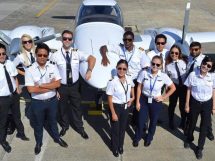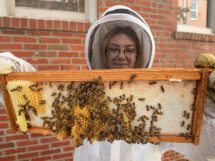
LOUISVILLE, Ky. (May 8, 2018) — Before diving at speeds of 200 miles per hour and fulfilling the title of “World’s Fastest Flying Birds,” four peregrine falcons nesting in Louisville will spend the next several weeks learning to fly. And, webcam viewers will have a live front row seat.
The webcam’s installed through a partnership with Kentucky Department of Fish and Wildlife Resources and located inside the peregrine falcon nest box 300 feet above ground at Louisville Gas and Electric Company’s Mill Creek Generating Station.
“Web cameras are an excellent way for people to learn about and observe wildlife without the risk of disturbing them,” said Loren Taylor, avian biologist with KDFWR. “This is especially important when it comes to peregrine falcons, as they are still considered a rare species in Kentucky.”
Viewers have watched since March while Diana, the female peregrine falcon believed to be nesting at this location since 2006, and her male companion have raised the four chicks.
According to Taylor, the new HD webcam with a higher resolution “has the potential to allow biologists to identify individual falcons by the unique characteristics of their facial plumage (feathers) in future years.”
Falcons typically learn to fly 40-45 days after hatching. The falcon chicks have become more active as they’ve matured and their muscles and skeletal structure have grown stronger. Before taking their first flight, the chicks are banded by KDFWR officials.
Watch this video to see officials band the falcon chicks.
During the banding process, the chicks are briefly removed from the nest to allow KDFWR officials to attach leg bands with unique color, letter and number combinations. This identifying information is then entered into a database along with each bird’s gender, hatch date and nest location. Biologists will be able to read the unique band combinations through high-powered optics.
LG&E and KDFWR launched the state’s first webcam inside this same nest box in 2013. Since then, Diana and her family have won the hearts and attention of more than 340,000 viewers.
Each year, Diana has nested at the box at Mill Creek from February through June and raised anywhere from two to four chicks.
Power plant crevices and alcoves remind the falcons of natural nesting locations, such as mountain cliffs and ledges. Falcons eat smaller birds, so an ample food supply of pigeons and starlings is readily available at the power plant.
Visit lge-ku.com/falcon to watch live as the young falcons prepare to fly.




















Add Comment